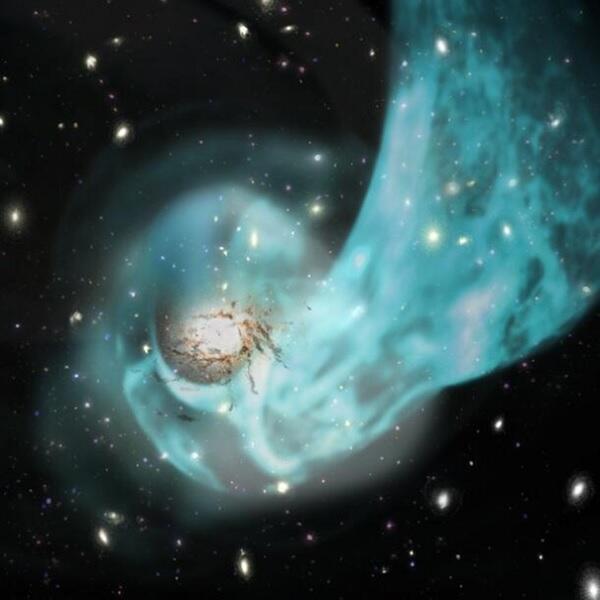A research group led by Professor Makoto Tashiro, Associate Professor Yukikatsu Terada, and Associate Professor Satoru Katsuda from the Graduate School of Science and Engineering at Saitama University has announced the discovery of high-speed hot gas flows in the core of the Centaurus galaxy cluster. This finding was made through observations with the X-ray Imaging and Spectroscopy Mission (XRISM) satellite. The results, which may help solve the long-standing mystery of heating mechanisms in galaxy cluster cores, were published in the February 12 issue of the international journal Nature.

©JAXA
Celestial bodies like our solar system and the Milky Way galaxy have gradually grown through the influence of gravitational forces between matter. Galaxy clusters, which consist of several dozen to thousands of galaxies, are formed by the enormous gravitational pull of unknown matter called dark matter. Within galaxy clusters, gas trapped by the strong gravity of dark matter becomes extremely hot—reaching tens of millions of degrees—and emits X-rays. The clusters also contain hydrogen and helium gases created during the "Big Bang nucleosynthesis," a major event immediately after the birth of the universe. These gases flow into the galaxy cluster and become super-heated to tens of millions of degrees due to the shock of falling into the cluster, emitting X-rays. Since the mass of gas contained in a single galaxy cluster is significantly larger than the total mass of galaxies, X-ray observations are essential for understanding galaxy cluster evolution.
The mystery is that hot gas in the core of galaxy clusters should cool down (radiative cooling phenomenon) by releasing energy through X-ray radiation if there is no heating mechanism, yet the temperature remains high. Solving this temperature maintenance mechanism is considered a crucial research challenge in the study of cosmic evolution history.
From December 2023 to January 2024, the research group observed the Centaurus galaxy cluster, located relatively close to Earth at about 100 million light-years away, using XRISM to study the movement of hot gas in the cluster's core.
The soft X-ray spectrometer (Resolve) aboard XRISM was used to analyze the X-ray spectrum of the Centaurus galaxy cluster core and examine the hot gas movements in detail. This observation required accurate spectroscopic analysis of the energy of emission lines detected in the spectrum, but conventional instruments lacked sufficient spectroscopic capability.
The research revealed that hot gas in the core of the Centaurus galaxy cluster is flowing toward Earth at speeds of 130 to 310 kilometers per second. This flow is thought to cause gas agitation, maintaining the high temperature in the galaxy cluster core. By comparing the observational results with computer simulation calculations, the researchers determined that the "sloshing" movement of the hot gas was caused by the influence of past galaxy cluster collisions and mergers.
Tashiro commented: "The large-scale motion of galaxy cluster plasma that we observed can address one of the answers to the long-standing mystery among researchers: 'how is the temperature in the core maintained where radiative cooling occurs.' It took about nine years from the ASTRO-H observation, which provided hints to solve this mystery, to reach the point where we can make observations that give us the answer. Currently, XRISM is conducting daily observations of various types of celestial objects, not just galaxy clusters. We expect that the power of precise X-ray spectroscopy using X-ray microcalorimeters, which have been revived in XRISM's observation instruments, will show us many answers and new mysteries."
Journal Information
Publication: Nature
Title: The bulk motion of gas in the core of the Centaurus galaxy cluster
DOI: 10.1038/s41586-024-08561-z
This article has been translated by JST with permission from The Science News Ltd. (https://sci-news.co.jp/). Unauthorized reproduction of the article and photographs is prohibited.




